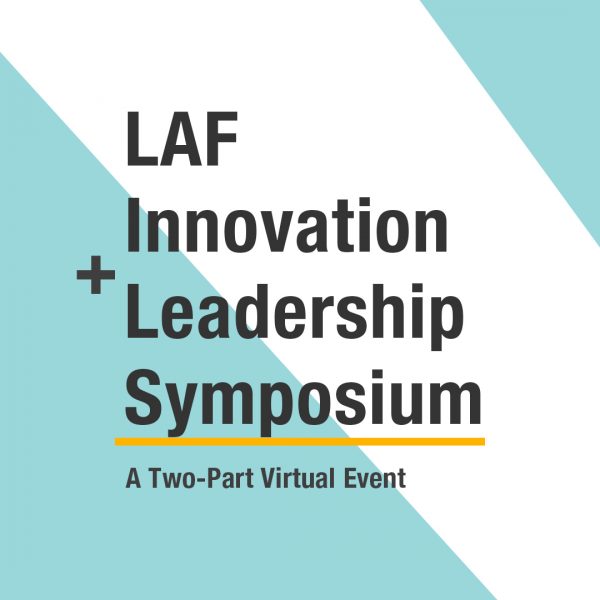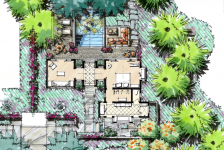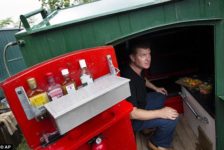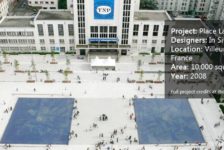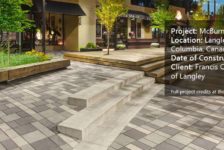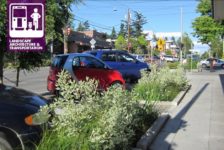This year’s annual LAF Innovation + Leadership Symposium showcased leading-edge thinking in landscape architecture to address a breadth of pressing issues. During this two-part virtual event, the six 2019-2020 LAF Fellowship for Innovation and Leadership recipients presented their projects as the culmination of their year-long fellowship. The symposium is a celebration of the fellows’ journey to develop their leadership capacity and work on ideas that have the potential to create positive and profound change in the profession, the environment, and humanity.
< RELATED: LAF Innovation + Leadership Symposium Goes Virtual: Part 1 >
Established in 2016, the Fellowship for Innovation and Leadership was created to “foster transformational leadership capacity and support innovations to advance the field of landscape architecture”. This $25,000 fellowship is an opportunity for professionals to dedicate the equivalent of 3 months’ time over the course of one year to a proposed project that has the potential to bring positive change and expand the discipline’s impact. The funds provide mid career and senior-level landscape architects the ability to think deeply, reflect, research, explore, create, test, and develop their ideas into action. In addition to the funds, the LAF Fellows receive project support through facilitated discussions, critiques, mentorship, and explorations of transformational leadership that occur during three 3-day residencies in Washington, DC, as well as monthly conference calls.
Like many recent events, the symposium saw a change of format this year and was hosted virtually. This is just one of the ways in which the coronavirus pandemic is expected to impact the landscape architecture profession. While quarantine has illustrated the importance of public space, it has also reminding us that access and treatment within these spaces in unequal. In a joint statement prepared by the 2019-2020 cohort, the Fellows recognize the systemic racism rooted in landscapes, and the progress to be made toward addressing urban inequity, stating: “Watching these events unfold, it became clear that the discourse in landscape architecture must change; that our work has too often been complicit in the marginalization and oppression of black and brown lives. It is up to us to imagine new futures, to dismantle oppressive power structures, and embrace our differences.”
In this moment of crisis, the urgency of the Fellow’s research topics have become even more apparent. As past LAF President Cindy Sanders stated, “Now, of all times, is not the time to stop programs that supports innovation and leadership development. The events of the last few months have only underscored our collective need for transformational leaders who can take us through these difficulties to a more sustainable, equitable, and just world.” This symposium provides a platform to bring important conversations to broader audiences and bring about much-needed societal change.
This online event was broken into two sessions, each day featuring presentations from three of the Fellows. The second session featured fellows Nick Jabs, Associate at PORT Urbanism, Pierre Bélanger, landscape architect and founder of the Landscape Infrastructure Lab, and Hans Baumann, an independent practicing landscape architect.
Nick Jabs – Working Landscapes and the Middle American City
In the design profession, there is lack of critical engagement with Middle American cities. Neither entirely rural or urban, the identity of these “smaller out-of-the-way towns” are often ignored, however their viability is critical and currently in danger. Fellow Nick Jabs set out to explore this often overlooked section of America in an effort to better understand the driving forces that have, and may in the future, shape its physical and cultural landscapes. In his presentation, Working Landscapes and the Middle American City, Jabs explores the past and present condition of Middle American cities through the evolution and intersection of their working landscapes.
Jabs’ research explores the shape of Middle America throughout time, and how the buildings, landscapes, and manufacturing infrastructure have changed along with it. Through a timeline of historical settlements, resource extraction, trade, transportation, and factory production, Jabs outlines the milestones that catalyzed change for the region. He argues that change, either in growth or decline, of post-colonial Middle American cities can consistently be linked back to the extraction and processing of natural resources or manufacturing. As he states, “The dual interwinding projects of capitalism and colonization manifests through manufacturing have shaped and reshaped the physical and perceived identity of Middle America, and especially the form of it is cities.”
Just as manufacturing has shaped and reshaped Middle America, so will our current climate crisis affect the future development of this region. Jabs argues that, due to their history, these communities are uniquely positioned to lead a low-carbon future, stating: “These communities not only have the natural, infrastructural, and physical capacities to make this happen. They have the cultural legacy as well. The very things that have defined the identity of Middle America are the necessary point-of-departure to make this transition.” He envisions a future in which Middle America is the engine for delivering the promises of the Green New Deal, providing decarbonization, justice, and jobs. The Green New Deal policy proposal would provide substantial investment in manufacturing and clean energy systems, places emphasis on bringing environmental, racial, and economic justice to vulnerable communities, and aims to meet 2030 and 2050 carbon goals. If enacted, we could witness a transformation of the region from one predicated on an extractive, destructive paradigm to one that is reciprocal and productive, with an interconnected relationship between the workers, the work being done, and the environment.
The identity and structure of this region has been shaped many times in the past, and it can be shaped again. In a final call-to-action, Jabs pronounces: “It is up to us – through our priorities, our budgets, our activism, and votes – to determine that future.”
Pierre Belanger – Landscape as Foundation for Revolution and Resistance
As landscape architects, we are stewards of the land. But whose lands we are on, and who are we accountable to? When we consider that the land in the U.S. and Canada was obtained through treaties with Indian tribes and acknowledge the history of these reservation lands lost to white development based on broken promises, we come to realize that we are accountable to the histories and legacies of those lands. Fellow Pierre Belanger provided a deeply moving and provocative presentation, Landscape as Foundation for Revolution and Resistance, that considers this question, opening a lens on the past to better understand the extreme climate of oppression and inequalities today. Presented in the form of spoken word, Belanger shares a letter he wrote to the editor of Landscape Architecture Magazine, Brad McKee, critically questioning the professional establishment and academic institution’s unwillingness to address matters of diversity, history, and legacy in landscape architecture.
Belanger proclaims that now is the time for the profession to confront its legacy rooted in dispossession, domination, and exploitation. “Our under-education of white supremacy, the inhumanity of design, and the injustice of the environment, our negligence, ignorance and silence are monumental,” he asserts. In order to clarify who we are as a profession and what our field represents, we must participate in a critical deep dialog and come to terms with histories of slavery and legacies of racism in the U.S. Landscape architects must decide if they want to champion change by engaging in deep dialogues about spatial injustice and racial erasure to rise up against legacies of white supremacy and dismantle settler colonialism. To work closer to the communities that we are accountable to, Belanger started a non-profit organization, OPEN SYSTEMS, and, with his co-founders, drafted a 38-point Deign Manifesto, continuing his mission to reclaim landscape, land, and life.
Hans Baumann – Immaterial Outcomes: Tribal Sovereignty and Design Collaboration at the Salton Sea
How would our understanding of the land change if landscape architects engaged more regularly with tribal communities? Tribal communities represent an incredibly diverse resource for understanding the places that we live and work, and yet we as design professionals do not acknowledge their expertise. Several of the 2019-2020 Fellows chose to research topics related to marginalized communities and tribal lands. However, Fellow Hans Baumann is the only to have immersed himself in a long-term collaboration with tribal members. In his presentation, Immaterial Outcomes: Tribal Sovereignty and Design Collaboration at the Salton Sea, Baumman reflects on his collaboration with the Torres Martinez Desert Cahuilla Indians of Southern California, sharing how landscape can act as a medium between design methodology and Indigenous knowledge. His work illustrates why landscape architects must engage with North America’s diverse tribal peoples, especially during the current era of unprecedented ecological change.
The tribal lands of the Torres Martinez Desert Cahuilla Indians surround the Salton Sea, the largest body of water in the state of California. Once a freshwater lake seen as a place of livelihood, the water quality has declined in recent years largely due to agricultural dumping, and the result is a shrinking, increasingly saline waterbody. Efforts are being made to better protect the quality of this important water resource, and Torres-Martinez is eager to take an active role in restoration efforts. As the largest private landowner in and around the Salton Sea in the lower Coachella Valley, the tribal community has a cultural connection to this unique ecosystem, however Baumman discovered that only 2.3% of maps in “Salton Sea Atlas” make reference to the Cahuilla peoples, tribal land holdings, or tribal reservations – effectively erasing the community’s ties to the region.
While this is very much an ecological issue, it is much more personal for the tribal community. And, while the tribe’s connection has been largely ignored to-date, their long-standing relationship to the land offers an important perspective. Baumann suggests that these cultural and ecological issues are interdependent and is working to bring the cultural perceptions to the maps and representational frameworks. In the Fall of 2017, Baumann met with the community’s tribal government, suggesting an inclusive approach to the Salton Sea crisis – one that emphasizes the community’s personal and cultural connections to the water. A partnership has since been formed, developed through a series of community workshops led by artists and culture bearers in the tribe and supported through a youth apprenticeship. Baumann’s role is to support the development of ideas in the community workshops and to facilitate continuity over the life of the project.
As an outsider, Baumann has learned much about the process of working with tribal communities, emphasizing that this work should not follow a linear process. Relationship building and trust is critical, and factors such as deadlines can turn relationships into transactions. Through this partnership, Baumann has concluded that we must dismantle the thinking and assumptions that exist in the field of landscape architecture that has historically isolated us from these tribal allies. We must reframe our role and understand that we are entering a long term process of listening and consensus-building. In conclusion, he states: “This is not a call for us to lead the way. What it is is a call for us to step aside; to make space; and to find the interest and capacity to support the work being done by tribal governments and tribal peoples now, in the present.“
—
Presentations from Part 2 of the 2020 LAF Innovation + Leadership Symposium can be viewed on the LAF website. Those seeking continuing education credits can earn 1.0 PDH (LA CES/HSW) following successful completion of a short quiz.



